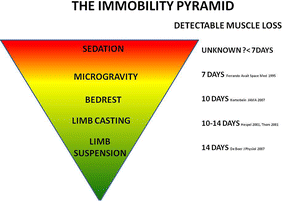The impact of extended bed rest on the musculoskeletal system in the critical care environment
- PMID: 26457181
- PMCID: PMC4600281
- DOI: 10.1186/s13728-015-0036-7
The impact of extended bed rest on the musculoskeletal system in the critical care environment
Abstract
Prolonged immobility is harmful with rapid reductions in muscle mass, bone mineral density and impairment in other body systems evident within the first week of bed rest which is further exacerbated in individuals with critical illness. Our understanding of the aetiology and secondary consequences of prolonged immobilization in the critically ill is improving with recent and ongoing research to establish the cause, effect, and best treatment options. This review aims to describe the current literature on bed rest models for examining immobilization-induced changes in the musculoskeletal system and pathophysiology of immobilisation in critical illness including examination of intracellular signalling processes involved. Finally, the review examines the current barriers to early activity and mobilization and potential rehabilitation strategies, which are being, investigated which may reverse the effects of prolonged bed rest. Addressing the deleterious effects of immobilization is a major step in treatment and prevention of the public health issue, that is, critical illness survivorship.
Keywords: Bed rest; Critical illness; Intensive care unit-acquired weakness; Muscle protein turnover; Muscle wasting; Rehabilitation; Sepsis.
Figures
References
Publication types
LinkOut - more resources
Full Text Sources
Other Literature Sources
Medical


